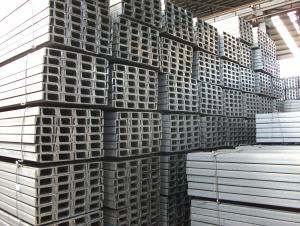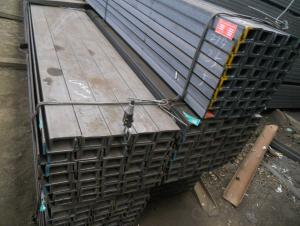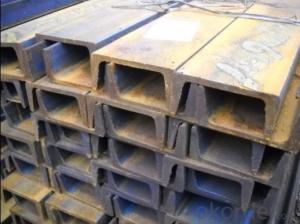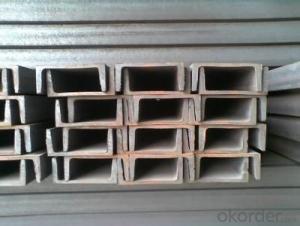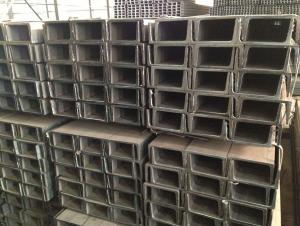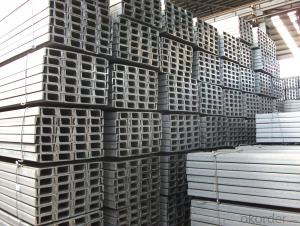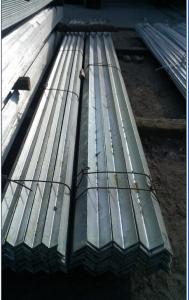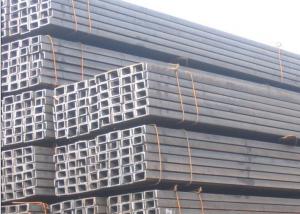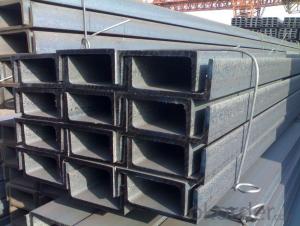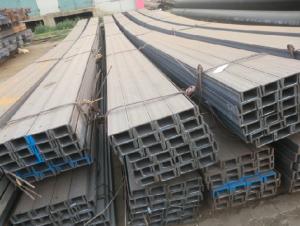GB Q235 Steel Channel
- Loading Port:
- China Main Port
- Payment Terms:
- TT OR LC
- Min Order Qty:
- -
- Supply Capability:
- -
OKorder Service Pledge
OKorder Financial Service
You Might Also Like
Product Description:
Specifications of MS Channel:
1.We supply high quality MS Channel at reasonable price, including Chinese standard, Japanese standard and so on.
Standard | GB |
Material Grade | Q235 |
Technique: | Hot Rolled |
Sizes as per chinese standard: | 50*37*4.5mm - 300*89*11.5mm
|
Sizes as per japanese standard: | 50*25*3mm – 200*80*7.5mm |
Length: | 6meter, 9meter, 12meter |
Note: 1.we are also competent to provide our customers other MS Channel based on other sizes according to customer’s requirements.
2. The length of our ms channel could be cut into other meters as per customer’s requirements. For example, the channel in 6meters could be cut into 5.8meters in order to be fit in the 20ft container.
2. The detailed sections of MS Channel as per GB standard.are shown in the table-1:
GB U CHANNEL | Standard | Sectional | Dimension |
| Mass: |
| (mm) | (mm) | (mm) | (mm) |
|
50X37 | 50 | 37 | 4.50 | 7.0 | 5.438 |
63X40 | 63 | 40 | 4.80 | 7.5 | 6.634 |
80x43 | 80 | 43 | 5.00 | 8.0 | 8.045 |
|
|
|
|
|
|
100x48 | 100 | 48 | 5.30 | 8.5 | 10.007 |
120x53 | 120 | 53 | 5.50 | 9.0 | 12.059 |
140x58 | 140 | 58 | 6.00 | 9.5 | 14.535 |
140x60 | 140 | 60 | 8.00 | 9.5 | 16.733 |
|
|
|
|
|
|
160x63 | 160 | 63 | 6.50 | 10.0 | 17.240 |
160x65 | 160 | 65 | 8.50 | 10.0 | 19.752 |
|
|
|
|
|
|
180x68 | 180 | 68 | 7.00 | 10.5 | 20.174 |
180x70 | 180 | 70 | 9.00 | 10.5 | 23.000 |
|
|
|
|
|
|
200x73 | 200 | 73 | 7.00 | 11.0 | 22.637 |
200x75 | 200 | 75 | 9.00 | 11.0 | 25.777 |
|
|
|
|
|
|
220x77 | 220 | 77 | 7.00 | 11.5 | 24.999 |
220x79 | 220 | 79 | 9.00 | 11.5 | 28.453 |
|
|
|
|
|
|
250x78 | 250 | 78 | 7.00 | 12.0 | 27.410 |
250x80 | 250 | 80 | 9.00 | 12.0 | 31.335 |
250x82 | 250 | 82 | 11.00 | 12.0 | 35.260 |
|
|
|
|
| |
280x82 | 280 | 82 | 7.50 | 12.5 | 31.427 |
280x84 | 280 | 84 | 9.50 | 12.5 | 35.823 |
280x86 | 280 | 86 | 11.50 | 12.5 | 40.219 |
|
|
|
|
|
|
300x85 | 300 | 85 | 7.50 | 13.5 | 34.463 |
300x87 | 300 | 87 | 9.50 | 13.5 | 39.173 |
300x89 | 300 | 89 | 11.50 | 13.5 | 43.883 |
Table-1
3. The chemical composition of HR Channel Steel according to Q235B is shown in Table-2.
Alloy No | Grade | Element(%) | ||||
C | Mn | S | P | Si | ||
Q235 | B | 0.12-0.20 | 0.3-0.7 | ≦0.045 | ≦0.045 | ≦0.3 |
Table-2
Note: we are able to present our customers relevant SGS test report for chemical composition of HR Channel Steel.
Applications of MS Channel:
The MS Channel can be applied to construction of warehouses, workshops, sport stadiums and car parks etc.The hot rolled channel steel belongs to carbon structural steel which is applied to in the field of construction and machinery.In details, the hot rolled channel steel is usually used for arch-itechtural structure, and they could be welded in order to support or hang a vari-ety of facilities. They are also usually used in combination with I beam. Generally,the hot rolled channel steel we supply must possess perfect welding property, riveting property and mechanical property and so on.
Package & Delivery of MS Channel:
1.The hot rolled channel steel will be packed in bundle with steel wire at each end of every bundle and color marking in order to help the customer to recognize his goods more easily at sight.
2. And the hot rolled channel steel could be loaded into 20ft or 40ft container, or by bulk cargo.If the weight of each bundle reaches more than 3.5 mt, the loading by break bulk cargo should be choosed.When the weight of each bundle reaches less than 3mt, the loading by container should be choosed.
3.As for the transportaion from mill to loading port, the truck will be usually used. And the maximum quantity for each truck is 40mt.
4.All in all, we could do in accordance with customer's request.
- Q: Can steel channels be used for pipe supports?
- Yes, steel channels can be used for pipe supports. Steel channels are often used in construction and engineering projects to provide structural support and stability. They can be effectively utilized as pipe supports due to their strength, durability, and ability to withstand heavy loads. Additionally, steel channels can be easily customized and fabricated to fit specific pipe sizes and configurations, making them a versatile choice for pipe support applications.
- Q: Can steel channels be customized to specific lengths?
- Indeed, it is possible to customize steel channels to meet specific length requirements. Although steel channels are typically found in standard sizes, they can be altered or trimmed to match the desired length. This customization process entails cutting the steel channel to the desired length and may also involve implementing welding or other techniques to uphold its structural integrity. The ability to customize steel channels offers enhanced flexibility in a variety of construction and engineering applications.
- Q: What are the different types of coatings available for steel channels?
- There are several types of coatings available for steel channels, including galvanized coatings, paint coatings, powder coatings, and epoxy coatings.
- Q: How do steel channels contribute to the stability of bridges?
- Playing a crucial role in bridge stability, steel channels, also known as structural channels or C-channels, have specific designs that enhance overall strength and provide structural support. To begin with, steel channels are utilized to support the bridge's deck or roadway. Typically installed horizontally, they serve as the primary load-bearing element, distributing weight evenly across the bridge from vehicles, pedestrians, and other loads. This effective transfer of loads prevents excessive stress or strain on individual components, ensuring the stability of the entire structure by transmitting the loads to the bridge's supporting piers or abutments. Furthermore, steel channels contribute to the lateral stability of bridges. When installed vertically, they act as bracing elements, resisting horizontal forces like wind or seismic activity that could cause the bridge to sway or deform. By effectively counteracting these forces, steel channels reduce the risk of structural failure and maintain stability even during adverse conditions. In addition to their load-bearing and bracing capabilities, steel channels offer flexibility in bridge design. Engineers can utilize their versatility to create different bridge configurations, such as truss or box girder bridges, to optimize strength and stability based on site-specific requirements. Moreover, steel channels are renowned for their durability and resistance to corrosion. This makes them an ideal choice for bridge construction, as they can withstand harsh environmental conditions like moisture, chemicals, and temperature fluctuations without compromising their structural integrity. By maintaining their strength over time, steel channels ensure the long-term stability and safety of the bridge. In summary, steel channels significantly contribute to bridge stability by providing load-bearing support, resisting lateral forces, allowing for flexible design options, and offering durability against corrosion. Their crucial role in bridge construction guarantees efficient and safe accommodation of various loads and environmental conditions, ensuring the safety and reliability of bridges for years to come.
- Q: What are the different corrosion protection methods for steel channels in marine environments?
- Steel channels in marine environments face a high risk of corrosion due to the presence of saltwater and harsh elements. To protect against corrosion, there are several methods available: 1. Coating: Applying protective coatings, such as epoxy, polyurethane, and zinc-rich paints, creates a barrier between the steel surface and corrosive elements. This prevents direct contact and subsequent corrosion. 2. Cathodic protection: This method utilizes sacrificial anodes or impressed current to safeguard steel channels. Sacrificial anodes made of zinc or aluminum are attached to the steel channels and corrode preferentially, sacrificing themselves to protect the steel. Impressed current systems use an external power source to provide a protective electrical current. 3. Galvanization: Galvanizing steel channels involves coating them with a layer of zinc, which acts as a sacrificial layer. This sacrificial layer corrodes instead of the steel, providing protection against corrosion in marine environments. 4. Stainless steel: Utilizing stainless steel channels is another effective method. Stainless steel contains chromium, which forms a passive oxide layer on the surface, safeguarding against corrosion. It is highly resistant to corrosion in marine environments and commonly used in critical applications. 5. Proper maintenance: Regular inspection, maintenance, and upkeep are crucial to prevent corrosion in steel channels. This includes removing marine growth, repairing coating damage, and ensuring proper drainage and ventilation to minimize exposure to corrosive elements. It is important to consider factors such as the severity of the marine environment, duration of exposure, and expected lifespan of the steel channels when selecting a corrosion protection method. Consulting corrosion engineers or specialists can assist in determining the most suitable protection method for specific marine applications.
- Q: What is the difference between C steel, U steel and channel steel?
- Channel steel: the channel steel is a long strip steel with a cross section. Channel steel is divided into ordinary channel steel and light channel steel. Standard Specification for hot-rolled plain channel steel is 5-40#. According to the channel shape and can be divided into 4 kinds: cold bending equilateral channels, cold-formed non equilateral channel steel, cold rolled edge channels, the cold bending edge channels in accordance with the steel structure theory, should be the steel flange force, that channel should be upright, not lying. Channel steel is mainly used in building structures, vehicle manufacturing and other industrial structures, and channel steel is often used in conjunction with i-beam. See 100 million steel tube for you to answer the content, C steel, U steel and channel of the difference is clear.
- Q: What is the difference between the main keel and the angle steel and the channel steel?
- Channel steel is a strip of steel with a cross section. Section steel with groove shape.Channel steel is a kind of carbon structural steel used for construction and machinery. It is a complex section steel. Its cross section has a groove shape. Channel steel is mainly used in building structure, curtain wall engineering, mechanical equipment and vehicle manufacturing, etc.. In use, it requires better welding, riveting performance and comprehensive mechanical properties. The raw material steel billet for channel steel is carbon or low alloy steel billets with a carbon content of not more than 0.25%. The finished channel steel is delivered by hot forming, normalizing or hot rolling. The specifications are expressed in millimeters of height (H) * leg width (b) * waist thickness (d), such as 100*48*5.3, which means waist height is 100 mm, leg width is 48 mm, waist thickness is 5.3 mm channel, or 10# channel steel. The same height of the channel, if there are several different leg width and waist thickness, also need to add a, B, C on the right side of the model to distinguish, such as 25#a, 25#b, 25#c and so on.
- Q: Can steel channels be used in solar panel installations?
- Solar panel installations can utilize steel channels. These channels, also referred to as steel C channels or steel U channels, are commonly employed in construction and industrial settings due to their strength, durability, and versatility. In the context of solar panel installations, steel channels can serve as robust support structures for mounting solar panels on rooftops or in ground-mounted systems. Steel channels offer a stable framework capable of withstanding the weight of solar panels and various weather conditions. They can be easily customized and fabricated to meet specific installation requirements, such as the size and angle of the solar panels. Moreover, steel channels can be galvanized or coated to provide corrosion resistance, ensuring the longevity of the solar panel installation. Additionally, steel channels provide flexibility in terms of design and layout. They can be seamlessly integrated with other mounting systems and components, including rails, brackets, and clamps, enabling efficient and secure solar panel installations. The adaptability of steel channels makes them suitable for both residential and commercial solar panel projects. To summarize, steel channels are a practical choice for solar panel installations due to their strength, durability, versatility, and compatibility with other mounting systems. They provide a sturdy foundation for mounting solar panels, guaranteeing a stable and efficient solar energy system.
- Q: 8# what's the size of the channel steel?
- Channel steel is a kind of carbon structural steel used for construction and machinery. It is a complex section steel. Its cross section has a groove shape. Channel steel is mainly used in building structure, curtain wall engineering, mechanical equipment and vehicle manufacturing, etc.. In use, it requires better welding, riveting performance and comprehensive mechanical properties. The raw material steel billet for channel steel is carbon or low alloy steel billets with a carbon content of not more than 0.25%. The finished channel steel is delivered by hot forming, normalizing or hot rolling. The specifications are expressed in millimeters of height (H) * leg width (b) * waist thickness (d), such as 100*48*5.3, which means waist height is 100 mm, leg width is 48 mm, waist thickness is 5.3 mm channel, or 10# channel steel. The same height of the channel, if there are several different leg width and waist thickness, also need to add a, B, C on the right side of the model to distinguish, such as 25#a, 25#b, 25#c and so on.
- Q: What are the different types of steel channel accessories?
- Some of the different types of steel channel accessories include brackets, clamps, connectors, end caps, and framing components. These accessories are used to provide additional support, connection options, and finishing touches to steel channel systems.
Send your message to us
GB Q235 Steel Channel
- Loading Port:
- China Main Port
- Payment Terms:
- TT OR LC
- Min Order Qty:
- -
- Supply Capability:
- -
OKorder Service Pledge
OKorder Financial Service
Similar products
Hot products
Hot Searches
Related keywords
